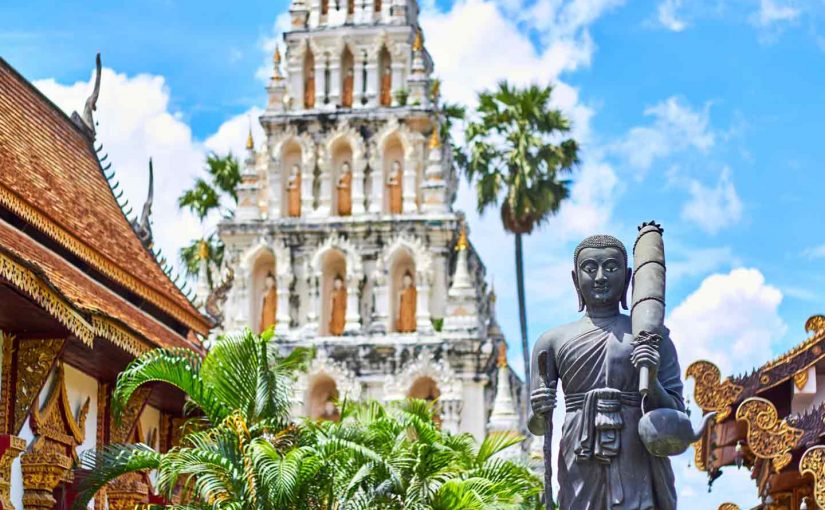History of Thailand: Everything You Need to Know!
Ah, Thailand! Home to exotic cuisine, beautiful beaches, and a fascinating history that spans centuries. In this article, we’ll take a journey through the history of Thailand – from ancient times to the present day. You’ll learn about its long-standing cultures, religions, and political developments, as well as its place in the world today. So come along and discover everything you need to know about the history of Thailand!
Table of contents:
- Part I: Ancient Times
- Part II: The Early Kingdoms
- Part III: Modern Times
- Modern-day Thailand
- Conclusion

Part I: Ancient Times
The roots of modern-day Thailand can be traced back more than 4,000 years ago. During this time, various tribal groups inhabited the region and formed primitive agricultural societies.
Around 3,000 BC, groups such as the Mons and Khmers began to migrate into the area, introducing their own culture and beliefs. By 1000 BC, these various cultures had coalesced into small states known as ‘mandala’, which were ruled by powerful kings or religious leaders.
Prehistory
The first inhabitants of Thailand were hunter-gatherer tribes who arrived in the region around 10,000 BC. They were followed by a variety of people, including Austroasiatic and Tai-Kadai speakers, who brought with them new tools and technologies such as pottery and bronze weapons.
As these settlers spread out across Thailand, they encountered a variety of animals – from elephants to tigers – as well as abundant natural resources like timber and fish. The region was also home to numerous tribes who practiced Animism and Theravada Buddhism, two of the oldest religions in Southeast Asia.
Funan Empire
The earliest known kingdom in Thailand was the Funan Empire which was established around 200 AD. It was centered in what is now southern Cambodia but extended its influence over much of what is now Thailand.
The Funanese were accomplished traders who maintained contact with Chinese merchants and adopted Chinese customs such as Confucianism and Mahayana Buddhism. They also developed an advanced irrigation system that allowed them to cultivate rice in abundance.
Mon-Khmer Kingdom
Around 400 AD, a new power emerged on the scene – the Mon-Khmer Kingdom (also known as Dvaravati). This kingdom was centered in central Thailand but also controlled parts of present-day Laos and Cambodia. The Mon-Khmer people were skilled architects who built elaborate temples dedicated to their deities.
They also introduced Theravada Buddhism, which quickly became popular among the people. During this period, trade between India and China flourished due to their strategic location at one of the busiest crossroads in Southeast Asia.

Part II: The Early Kingdoms
From 700 AD onwards, several powerful kingdoms emerged in what is now Thailand. These included Sukhothai (1238–1438), Ayutthaya (1350–1767), and Thonburi (1767–1782). During this period, trade flourished between these kingdoms and other countries like China and India while local arts such as literature and architecture reached new heights of sophistication. In addition, Theravada Buddhism spread throughout the region while contact with foreign traders resulted in further cultural exchange between different countries in Asia.
Sukhothai Kingdom
The first major Thai kingdom was Sukhothai which reigned from 1238–1438 CE during what is now referred to as ‘the Golden Age’ of Thai history. It was an independent state which enjoyed close relations with both China and India thanks to its position at one of the most important trading routes between these two countries at that time.
During this period, Thai art flourished while Theravada Buddhism has firmly established as the state religion thanks to King Ramkhamhaeng’s efforts to promote it within his kingdom.
Ayutthaya Kingdom
The next great power in Thailand was Ayutthaya which reigned from 1350–1767 CE during what is now called ‘the Imperial Period’ of Thai history. Under its rule, trade with China increased significantly while diplomatic ties with neighboring states were also strengthened thanks to its strong navy, which enabled it to dominate much of Southeast Asia’s sea lanes during this time period.
In addition to being a powerful trading nation during this period, Ayutthaya was also home to some of the most advanced architectural works of that era, including numerous impressive temples dedicated to Buddhism, such as Wat Phra Si Sanphet Temple Complex located inside its capital city Ayutthaya itself.
Thonburi Kingdom
Following Ayutthaya’s fall in 1767 CE came Thonburi, which ruled from 1767–1782 CE during what is now referred to as ‘the Early Bangkok Period’ of Thai history.
This kingdom saw increased contact with Europeans thanks to its advantageous position at one end of the Mekong River, where various ships carrying spices from India regularly docked, seeking goods such as textiles from Siam (as it was then known).
This enabled Thonburi’s rulers to amass great wealth while their strong navy ensured that they remained an important player in Southeast Asian politics throughout their brief reign.

Part III: Modern Times
By 1809 CE Siam had become an independent country, with Bangkok serving as its capital city. As Europe’s influence grew in Southeast Asia during this period, so did Siam’s trading links with western nations. This opened up new opportunities for economic growth for Siamese rulers who welcomed westerners into their country.
Siam also underwent a period of modernisation during this time, with many aspects of government becoming more centralised under one ruler. These reforms culminated in 1932 when Siam changed its name to Thailand after overthrowing the absolute monarchy. This ushered in a new era for Thai politics marked by parliamentary democracy.
World War II
During World War II, Japan occupied parts of Southeast Asia, including present-day Thailand. The Japanese military forces made use of various resources found within Thailand, such as coal, rubber, tin, iron ore, lead, zinc, etc, all for their own benefit.
Despite harsh conditions imposed by occupying forces, many Thais resisted occupation through peaceful means, including demonstrations, boycotts, etcetera, while others took up arms against Japanese soldiers.
After Japan’s surrender in 1945, independence returned once again to Thailand, although her relations with Europe remained strained due largely due her stance on siding with Japan against allied forces during wartime conflict.
Cold War & Vietnam War
During the post-war era, Thailand sided mainly with the United States mostly due to its policy towards communism hence forming strong relations between the two countries leading up until the late 1970s when the Vietnam war broke out.
For the sake of supporting the US, Thailand provided logistical support by allowing US bases within her borders, thus playing a major role in American success during the Vietnam war. In return, the US provided a vast amount of economic aid, allowing rapid development within the country and propelling her even further forward towards becoming the developed nation we see today.
21st Century
In the 21st century, Thailand has established itself both economically and politically, making her one most stable nations within the region despite occasional political turbulence due largely to internal issues such as democratic regime changes and political power struggles every so often occurring mainly in urban cities like Bangkok capital city itself whilst rural areas remain largely unaffected by all said turmoil going on within larger cities metropolitan areas respectively.
Present Day
Presently however situation has looked better in the last few years since the military coup took place in 2014 after former Prime Minister Yingluck Shinawatra stepped down amidst mass protests which eventually led to the formation of the National Council Reform, resulting establishment of the new government under the current Prime Minister Prayuth Chan-ocha’s command helping restore some order peace among citizens country while still maintaining democratic values rights throughout many nations respectively. Moreover making sure military doesn’t meddle too much business civilian politics something which remains priority everyone looking forward future stability peace prosperity within the nation itself.

Modern-day Thailand
That being said, let us now explore all that modern-day Thailand has to offer: its economy, culture, education system, and political environment. So read on and discover everything you need to know about Thailand today!
The Economy
Thailand is Southeast Asia’s second-largest economy and is rapidly growing. The country has seen strong economic growth over the past two decades, which is largely attributed to its focus on exports.
In particular, agricultural products such as rice and rubber have been major contributors to the economy. Tourism is also an important part of the economy; in 2019, tourism accounted for about 10% of the GDP.
In addition, the manufacturing industry is a major driver of economic growth in Thailand. The automotive industry is particularly successful; in 2019, it was the fifth-largest producer of cars in the world.
Culture
Thailand is known for its rich culture and heritage, with strong influences from Buddhism, Hinduism, Chinese cultures, and Western countries like the United Kingdom and the United States. For example, Thai food incorporates many traditional dishes from neighboring countries as well as dishes with Western influence.
Thai dance also shows influences from many different cultures – most notably classical Indian dance styles. There are also many cultural festivals throughout the year that celebrate different aspects of Thai cultures, such as Songkran (Thai New Year) and Loy Krathong (Festival of Lights).
Education System
The education system in Thailand consists of three levels: primary education (ages 6-12), secondary education (ages 12-18), and tertiary education (18+). Primary education is free for all citizens under the age of 18; however, some private schools offer additional services for a fee.
Secondary education is also offered by both public and private institutions; however, students must pay tuition fees for both types of schools. Finally, tertiary education includes universities as well as specialized vocational schools that offer courses such as business administration and engineering.
Political Environment
The political environment in Thailand is complex due to its long history of military coups d’état since 1932. Current government is led by Prime Minister Prayut Chan-o-cha, who was elected in 2019 after leading a military junta from 2014-2019.
The government has prioritised economic development while attempting to maintain political stability through a series of reform measures, including curbing press freedom and creating new laws that criminalise certain forms of dissent.
Infrastructure
Thailand boasts an impressive infrastructure network that includes an extensive network of roads connecting major cities across the country. Additionally, there are two international airports in Bangkok – Suvarnabhumi Airport and Don Mueang Airport – which serve millions of passengers each year.
The railway system consists of five lines running between cities throughout the country; there are also numerous buses that connect small towns throughout rural areas. Finally, there are several ports located along the coastlines providing access to international trade routes for goods traveling in and out of Thailand by sea.
Technology & Innovation
Thailand has made significant investments in technology infrastructure over recent years, particularly in terms of internet connectivity and digital services such as e-commerce platforms.
Moreover, there are numerous tech startups based out of Bangkok that has attracted venture capital investment from across the globe due to their innovative products or services.
Additionally, Thailand has made strides towards becoming a regional leader in renewable energy, with ambitious plans for renewable energy sources such as solar energy being put into action over recent years.

Conclusion
The history of Thailand is rich and varied – spanning thousands of years from ancient times through modernity up until today’s world! You’ve explored everything you need to know about its origins – from early tribal groups through early civilisations like Funan and Dvaravati; powerful kingdoms like Sukhothai; conflicts like World War II; up until today’s bustling economy and democracy! With our journey complete – you should have a much better understanding of how far back Thai culture stretches – from ancient times all the way through modernity!
















